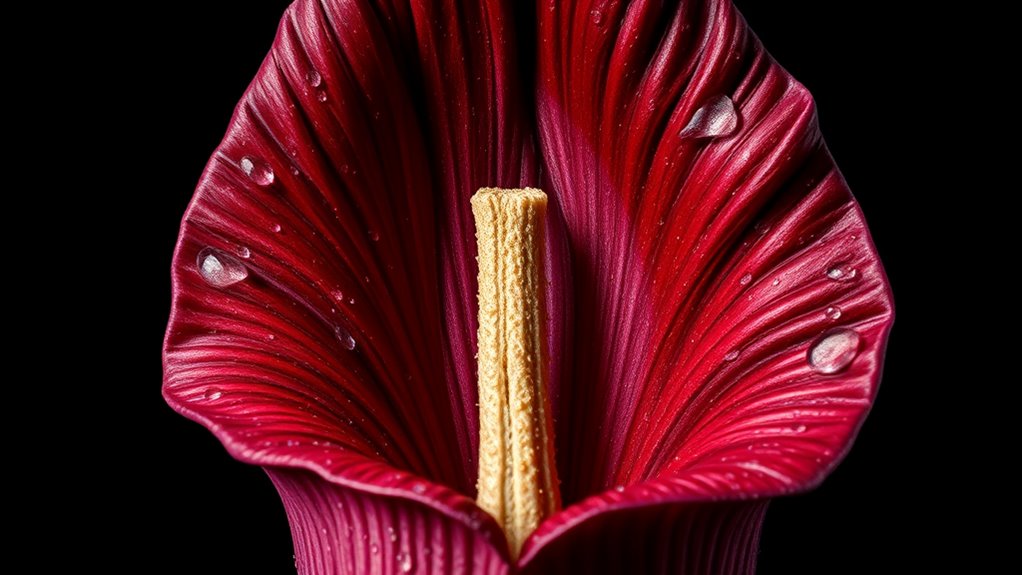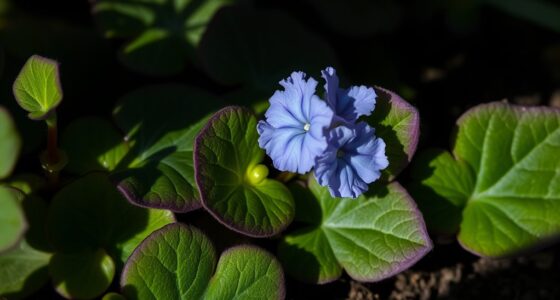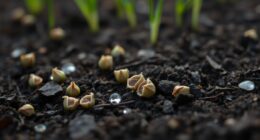The giant, stinky bloom of the corpse flower is triggered by a combination of environmental signals and internal energy reserves. Warmth, moisture, and temperature shifts prompt the plant to start its rapid flowering process. Over years, it accumulates nutrients and energy until it’s ready to bloom, usually in response to seasonal cues or stressors. As the stalk rises, it signals the bloom’s imminent opening—keep going to uncover more about what makes this rare event happen.
Key Takeaways
- Warm temperatures and increased humidity act as primary environmental triggers for blooming.
- Energy stored in the tuber over years is essential to initiate flowering.
- A noticeable rise of the leafless stalk signals the plant is preparing to bloom.
- Sudden temperature shifts or stress signals can prompt the flower to develop.
- The bloom occurs rapidly, usually within 24 to 48 hours, after environmental and internal cues align.

If you’re waiting for the rare bloom of the corpse flower, the countdown has officially begun. This giant, foul-smelling plant is famous for its unpredictable flowering cycle, which can take years or even decades to occur. When the time finally comes, it’s a spectacle that draws crowds enthusiastic to witness its brief, pungent display. But understanding what triggers this bloom can help you anticipate its arrival more accurately. The process centers around the plant’s unique biology and environmental conditions. The corpse flower, or Amorphophallus titanum, develops from a tuber that stores energy over time. As it prepares to bloom, it channels this energy into a massive spadix—the central, fleshy spike—that pushes upward through the spathe, a large leaf-like sheath. This growth phase is fueled by specific signals, primarily temperature, light, and soil conditions.
The flowering process is triggered when the plant perceives the right combination of warmth and moisture. Typically, after several years of growth, the tuber accumulates enough nutrients and energy to initiate flowering. During this period, you might notice the plant’s leafless stalk rising sharply, signaling that it’s gearing up for a bloom. Temperature plays a vital role; the plant favors warm, humid conditions similar to its native rainforests in Sumatra. Sudden shifts in temperature or increased rainfall can signal the plant to start flowering. Additionally, the plant’s internal clock, possibly influenced by seasonal cues, helps determine the timing. When all these factors align—ample energy reserves, suitable warmth, and humidity—the plant begins the process of flowering. Interestingly, some researchers believe that the plant may also respond to environmental stressors to initiate blooming.
Once initiated, the flowering cycle is remarkably rapid, often lasting only 24 to 48 hours. During this short window, the corpse flower emits its infamous odor—an intense smell of rotting flesh—to attract pollinators like carrion beetles and flesh flies. The foul smell is a pivotal part of its reproductive strategy, and it’s this smell that often causes excitement or discomfort among observers. As the bloom reaches full size, it peaks in scent and heat, mimicking decaying organic matter to lure pollinators. After pollination, the plant’s energy shifts from flowering to developing seed pods, and the bloom withers quickly. Understanding these triggers and signals can heighten your anticipation, turning the waiting into a more informed and engaging experience.
Frequently Asked Questions
How Long Does the Corpse Flower Typically Take to Bloom?
It usually takes 7 to 10 years for a corpse flower to bloom. During this time, you might notice it developing a tall, leaf-like structure called a pseudostem, which stores energy. When the flower is ready, it rapidly blooms within 24 to 48 hours. The process is unpredictable, so you should stay alert for any signs of blooming, especially if you’re waiting to see this rare, giant flower in action.
Can the Bloom Be Predicted More Accurately With Technology?
Yes, you can predict the bloom more accurately with technology. Researchers use sensors to monitor temperature, humidity, and plant signals, which help track the flower’s development. By analyzing this data, you can get a better idea of when the bloom might happen. While predictions aren’t perfect, using technology considerably improves your chances of catching the bloom at its peak, making the experience more exciting and informed.
What Environmental Factors Most Influence the Blooming Process?
Did you know that temperature fluctuations and soil moisture are key factors influencing bloom timing? You’ll notice that warmer night temperatures and increased humidity often trigger the flowering process. You should monitor these conditions closely, as even small changes can accelerate or delay blooming. By understanding these environmental cues, you can better anticipate when the giant, stinky bloom will appear, making your observation experience even more fascinating.
How Often Does a Typical Corpse Flower Bloom?
A typical corpse flower blooms once every 7 to 10 years, though it can sometimes take up to 15 years. When it finally blooms, it lasts only 24 to 48 hours. During this rare event, you’ll notice its enormous size, foul smell, and striking appearance. The long wait makes each bloom a special event, so be prepared for an exciting, albeit brief, natural spectacle when it happens.
Are There Health Risks Associated With the Smell?
Ever wondered if the smell poses health risks? While the scent is incredibly strong and unpleasant, it’s generally harmless in small doses. You might find the odor irritating or cause temporary nausea if you’re sensitive, but exposure isn’t likely to cause serious health issues. Just avoid prolonged inhalation, especially if you have respiratory issues. Would you want to be near a giant, stinky bloom for hours? Probably not, but brief exposure is safe.
Conclusion
As the corpse flower prepares to bloom, it’s a powerful reminder that nature’s cycles mirror our own. Like a midnight hour approaching, it signals transformation and patience, urging you to embrace the wait. When the giant bloom finally unfurls, it’s a symbol of resilience—beauty emerging from darkness. Just as the flower’s stench draws attention, let this moment remind you that growth often comes from the most unexpected, even stinky, places.










